Proposal of Agro-Industrial Integration Heat Transport System Using High-Performance Medium for the Realization of a Sustainable Society
Abstract
:1. Introduction
2. Assumption of Target Area
2.1. Outline of the Target Area
2.2. Heat Transport and Its Supply Method
3. Calculation of Supply in the Industrial Area
3.1. Heat Supply Cost
3.2. Transportation Costs
4. Calculation of Demand in the Agricultural Area
4.1. Heating Demand for Heat Transport
4.2. CO2 Demand
4.3. Effect of Increasing Yield by CO2 Application and Dehumidification
5. Case Study for Simulation
6. Simulation Results and Discussion
6.1. Simulation Results for Economic Aspects
6.2. Simulation Results for Environmental Aspects
7. Discussion
7.1. Discussion of Simulation Results
7.2. Consideration of the Reduction of Transportation Costs and Heat Transportation Systems to Small-Sized Greenhouses
8. Conclusions
Author Contributions
Funding
Institutional Review Board Statement
Informed Consent Statement
Acknowledgments
Conflicts of Interest
Nomenclature
| HC1 | The case where only heat is transported by HASClay in winter, |
| HC2 | The case where heat and CO2 are supplied simultaneously, |
| HC3 | The case where HASClay is supplied for dehumidification and CO2 application in summer in addition to the supply of heat and CO2 in winter. |
| (HO) | The case of heating with fuel oil, which is the conventional method |
| (A) | The case of growing tomatoes in a conventional greenhouse without heating energy in winter. |
| (B) | The case of growing tomatoes in a conventional greenhouse in summer. |
References
- Segawa, K. Japan’s implementation of sdgs, focusing on material cycles and waste management. Mater. Cycles Waste Manag. Res. 2017, 28, 403–411. (In Japanese) [Google Scholar] [CrossRef] [Green Version]
- Namazu, M.; Fujimori, S.; Matsuoka, Y. Towards halving global greenhouse gas emission—An analysis of emissions reduction in southeast asia. J. Jpn. Soc. Civ. Eng. 2013, 69, 85–95. (In Japanese) [Google Scholar]
- Wang, W.; Li, H.; Hou, X.; Zhang, Q.; Tian, S. Multi-Criteria Evaluation of Distributed Energy System Based on Order Relation-Anti-Entropy Weight Method. Energies 2021, 14, 246. [Google Scholar] [CrossRef]
- Sornek, K. Prototypical biomass fired micro-cogeneration systems energy and ecological analysis. Energies 2020, 13, 3909. [Google Scholar] [CrossRef]
- Ibrahimi, N.; Gebremedhin, A.; Sahiti, A. Achieving a flexible and sustainable energy system—The case of Kosovo. Energies 2019, 12, 4753. [Google Scholar] [CrossRef] [Green Version]
- Pan, L.; Guo, Z.; Liu, P.; Ma, L.; Li, Z. Comparison and analysis of macro energy scenarios in china and a decomposition-based approach to quantifying the impacts of economic and social development. Energies 2013, 6, 3444. [Google Scholar] [CrossRef] [Green Version]
- Kodama, A. Heat transportation experiment report by latent heat storage transportation system. Trans. JSME J. Ser. C Mech. Syst. Mach. Elem. Manuf. 2016, 116, 256–259. (In Japanese) [Google Scholar]
- Mizuno, A. The possibility of use in the region of the low temperature heat depends on the heat transportation network. Refrigeration 2008, 83, 530–538. (In Japanese) [Google Scholar]
- Iwai, Y. Heat transport by transformer heat container. Clean Energy 2013, 22, 55–59. [Google Scholar]
- Katayama, S.; Yamamoto, Y.; Saito, O.; Moriok, T. Evaluation of CO2 emission reduction by off-line supply system of exhaust heat generated from industrial plants. Environ. Syst. Res. 2008, 36, 97–104. (In Japanese) [Google Scholar] [CrossRef] [Green Version]
- Kaizawa, A.; Kamano, H.; Kawai, A.; Jozuka, T.; Senda, T.; Maruoka, N.; Okinaka, N.; Akiyama, T. Technical feasibility study of waste heat transportation system using phase change material from industry to city. ISIJ Int. 2008, 48, 540–548. (In Japanese) [Google Scholar] [CrossRef] [Green Version]
- Maruoka, N.; Akiyama, T. Thermal stress analysis of PCM encapsulation for heat recovery of high temperature waste heat. J. Chem. Eng. Jpn. 2003, 36, 794–798. (In Japanese) [Google Scholar] [CrossRef]
- Shikata, I.; Iwai, Y. Thermal energy transportation—Possibility of utilization low temperature waste heat by heat transportation. Energy Resour. 2008, 11, 88–92. [Google Scholar]
- Nouchi, I. Emission of greenhouse gases in the agriculture sector in japan and their reduction. J. Jpn. Soc. Atmos. Environ. 2006, 41, 103–122. [Google Scholar]
- Rafique, A.; Williams, P. Reducing household greenhouse gas emissions from space and water heating through low-carbon technology: Identifying cost-effective approaches. Energy Build. 2021, 248, 11162–11173. [Google Scholar] [CrossRef]
- Tanaka, A.; Takahashi, K.; Masutomi, Y.; Hanasaki, N.; Hijioka, Y.; Su, X.; Hasegawa, T.; Fujimori, S.; Masui, T. Development of impact functions of global crop yield for climate change policy support models. Clim. Biosph. 2014, 14, 41–56. (In Japanese) [Google Scholar] [CrossRef] [Green Version]
- Kawashiro, H.; Tsuchiya, K.; Sakiyama, H.; Udagawa, Y. Effects of low-concentration carbon dioxide supplementation on fruit yield and economic value of cucumber on forced culture. Hortic. Res. 2009, 8, 445–449. (In Japanese) [Google Scholar] [CrossRef]
- Suzuki, M.; Maeda, M.; Inukai, K. Development of HASClay as a high-performance adsorption material. Synthesiology 2016, 9, 154–164. (In Japanese) [Google Scholar] [CrossRef] [Green Version]
- Kawakami, Y.; Sue, N.; Yano, M.; Miyahara, H.; Kawamura, M.; Marumo, K.; Yamauchi, K.; Suzuki, M. Development of adsorption thermal storage system utilizing low-temperature waste heat-1. Tech. Pap. Annu. Meet. Soc. Heat. Air-Cond. Sanit. Eng. Jpn. 2018, 2, 141–144. (In Japanese) [Google Scholar]
- Kamata, H.; Tanino, M.; Kawakami, Y.; Oyama, T.; Matsuda, S.; Suzuki, M.; Marumo, K.; Yamauchi, K.; Miyahara, H.; Matsunaga, K. Development of open-type adsorption thermal storage heat pump system applying HASClay—Part 1—Experimental results of small equipment and calculation model of adsorption thermal storage tank. Trans. Soc. Heating. Air-Cond. Sanit. Eng. Jpn. 2020, 281, 9–16. (In Japanese) [Google Scholar]
- Miyahara, H.; Suzuki, M.; Matsuda, S.; Morimoto, K.; Manfuku, K.; Kawakami, Y.; Nawa, H.; Yamauchi, K.; Matsunaga, K.; Tanino, M. Development of open-type adsorption thermal storage heat pump system applying HASClay -part2 -hydration heat caused by water vapor adsorption on low-temperature regenerative heat storage material. Trans. Soc. Heating. Air-Cond. Sanit. Eng. Jpn. 2020, 285, 1–8. (In Japanese) [Google Scholar]
- Suzuki, M.; Oyama, T.; Nawa, H.; Imori, M.; Magome, H.; Kawakami, Y.; Inoue, M.; Tanino, M. Development of adsorption thermal storage system utilizing low-temperature waste heat—3rd report—Verification test of heat storing and releasing characteristics on actual equipment and factory. Trans. Soc. Heat. Air-Cond. Sanit. Eng. Jpn. 2018, 35, 149–152. (In Japanese) [Google Scholar]
- Kawakami, Y.; Tanino, M.; Suzuki, M.; Miyahara, H.; Suzuki, M.; Nawa, H. Development of adsorption thermal storage system utilizing low-temperature waste heat—4th report—Demonstration test of stationary type thermal storage system. Trans. Soc. Heat. Air-Cond. Sanit. Eng. Jpn. 2020, 2, 185–188. (In Japanese) [Google Scholar]
- Kawakami, Y.; Kamada, M.; Tanino, M.; Yamauchi, K.; Imori, M.; Maruge, K.; Miyahara, H.; Matsunaga, K.; Suzuki, M.; Matsuda, S. Demonstration development of HASClay adsorbent heat storage / offline heat transport system that can utilize low-temperature waste heat of 100 °C or less. Clean Energy 2020, 29, 26–32. [Google Scholar]
- Yamamoto, H.; Yamaji, K. Concept of carbon-related energy to connect energy consumption with CO2 Emissions. J. Jpn. Inst. Energy 2021, 100, 62–72. [Google Scholar] [CrossRef]
- Hori, T. Effect of environmental consideration of selection of vegetables in season and the consumption realities of the main vegetable. J. Kyoto Seika Univ. 2011, 39, 21–47. (In Japanese) [Google Scholar]
- Yoshida, S. Analysis of energy input for irrigation and drainage in lowland paddy farming. J. Irrig. Eng. Rural. Plan. 2011, 79, 357–365. [Google Scholar]
- Nishizono, H. A study of biomass use for heating energy in the tomato production. Annu. Rep. Fac. Educ. Gunma Univ. Art 2008, 43, 219–227. (In Japanese) [Google Scholar]
- Takano, A.; Kikuchi, S.; Kinomoto, M.; Tajima, Y.; Goto, T.; Haneishi, S.; Oshima, K. Development of energy-saving cultivation technology for high production of tomatoes using heat storage type environmental control system. Bull. Tochigi Prefect. Agric. Exp. Stn. Bull. Tochigi Agric. Exp. Stn. 2018, 77, 13–27. (In Japanese) [Google Scholar]
- Udagawa, T. Energy and agriculture. J. Agric. Meteorol. 1978, 33, 199–207. [Google Scholar] [CrossRef]
- Yoshikawa, N.; Amano, K.; Shimada, K. Quantitative evaluation of environmental load in vegetable production and transportation process. Environ. Syst. Res. 2006, 34, 245–251. [Google Scholar] [CrossRef] [Green Version]
- Yoshikawa, N.; Amano, K.; Shimada, K. Evaluation of the environmental load associated with Japanese fruit and vegetable consumption and its reduction potential. Environ. Syst. Res. 2007, 35, 499–509. [Google Scholar] [CrossRef]
- Shiraki, T.; Tachibana, R.; Tachibana, J.; Goto, N.; Fujie, K. A study on transition of CO2 emission by vegetable production. J. Jpn. Agric. Syst. Soc. 2008, 24, 11–17. (In Japanese) [Google Scholar]
- Tempaku, T.; Kosaki, Y.; Ishikawa, M.; Kasahara, S. Life cycle CO2 assessment associated with vegetable production and its distribution. In Proceedings of the Japan LCA Society Research Presentation, Nagoya, Japan, 28 February 2007; pp. 18–19. [Google Scholar]
- Nishizono, H.; Mogi, H. Study of environment evaluation by LCA method on production and distribution of vegetables. Annu. Rep. Fac. Educ. Gunma Univ. Art Technol. 2007, 42, 145–157. (In Japanese) [Google Scholar]
- Shigeaki Ueno, S.; Orikasa, T. Life cycle assessment analysis of agricultural distribution. Refrigeration 2014, 89, 31–36. [Google Scholar]
- Tahara City Agricultural Administration Division. Survey of Tahara City Agriculture. Available online: http://www.city.tahara.aichi.jp/kankou/nogyou/1005074/index.html (accessed on 10 September 2021). (In Japanese).
- Higashi Mikawa Regional Research Center. Survey of Facility Gardening Accumulation Including Plant Factories in San-en Area. Available online: https://www.hrrc.jp/pdf/04/h24/itaku_09.pdf (accessed on 10 September 2021). (In Japanese).
- Matsuo, S.; Umeda, H.; Takeya, S.; Fujita, T. A feasibility study on hydrate-based technology for transporting CO2 from industrial to agricultural areas. Energies 2017, 10, 728. [Google Scholar] [CrossRef] [Green Version]
- Umeda, H.; Ahn, D.; Iwasaki, Y.; Matsuo, S.; Takeya, S. A cooling and CO2 enrichment system for greenhouse production using CO2 clathrate hydrate Original. Eng. Agric. Environ. Food 2015, 8, 307–312. [Google Scholar] [CrossRef]
- Matsuo, S.; Inatsu, K.; Fujita, T. Energy evaluation of the cement manufacturing process using natural gas-hydrate technology in consideration of CO2 separation. J. Inst. Energy 2011, 90, 152–163. (In Japanese) [Google Scholar] [CrossRef] [Green Version]
- Takeya, S.; Hori, A.; Hondoh, T.; Uchida, T. Freezing-memory effect of water on nucleation of CO2 hydrate crystals. J. Phys. Chem. B 2000, 104, 4164–4168. [Google Scholar] [CrossRef]
- Takeya, S.; Muromachi, S.; Maekawa, T.; Yamamoto, Y.; Mimachi, H.; Kinoshita, T.; Murayama, T.; Umeda, H.; Ahn, D.; Iwasaki, Y.; et al. Design of ecological CO2 enrichment system for greenhouse production using TBAB + CO2 semi-clathrate hydrate. Energies 2017, 10, 927. [Google Scholar] [CrossRef] [Green Version]
- Environmental Agriculture Promotion Division. Agricultural Promotion Department, Kochi Prefecture, Survey Report on Energy Conservation in Horticultural Agriculture. Available online: https://www.pref.kochi.lg.jp/soshiki/111901/files/2012062500570/2012062500570_www_pref_kochi_lg_jp_uploaded_attachment_74650.pdf (accessed on 10 September 2021). (In Japanese).
- Tanigawa, T.; Kobayashi, Y.; Matsui, H. Effect of CO2 Enrichment and day temperature on growth, flowering and cut flower quality in dendranthema grandiflorum kitamura. Environ. Control. Biol. 1997, 35, 107–115. [Google Scholar] [CrossRef]
- Nakano, A.; Ahn, D. CO2 application technology for facility production suitable for a low-carbon society. Agric. Hortic. 2010, 85, 1071–1079. [Google Scholar]
- Christodoulides, P.; Agathokleous, R.; Aresti, L.; Kalogirou, S.; Tassou, S.; Florides, G. Waste heat recovery technologies revisited with emphasis on new solutions, including heat pipes, and case studies. Energies 2022, 15, 384. [Google Scholar] [CrossRef]
- Cruz, I.; Wallén, M.; Svensson, E.; Harvey, S. Electricity generation from low and medium temperature industrial excess heat in the kraft pulp and paper industry. Energies 2021, 14, 8499. [Google Scholar] [CrossRef]
- Jara Laso, J.; Hoehn, D.; Margallo, M.; García, I.; Batlle, L.; Bala, A.; Fullana, P.; Ian Vázquez, I.; Irabien, A.; Aldaco, R. Assessing energy and environmental efficiency of the spanish agri-food system using the LCA/DEA methodology. Energies 2018, 11, 3395. [Google Scholar] [CrossRef] [Green Version]



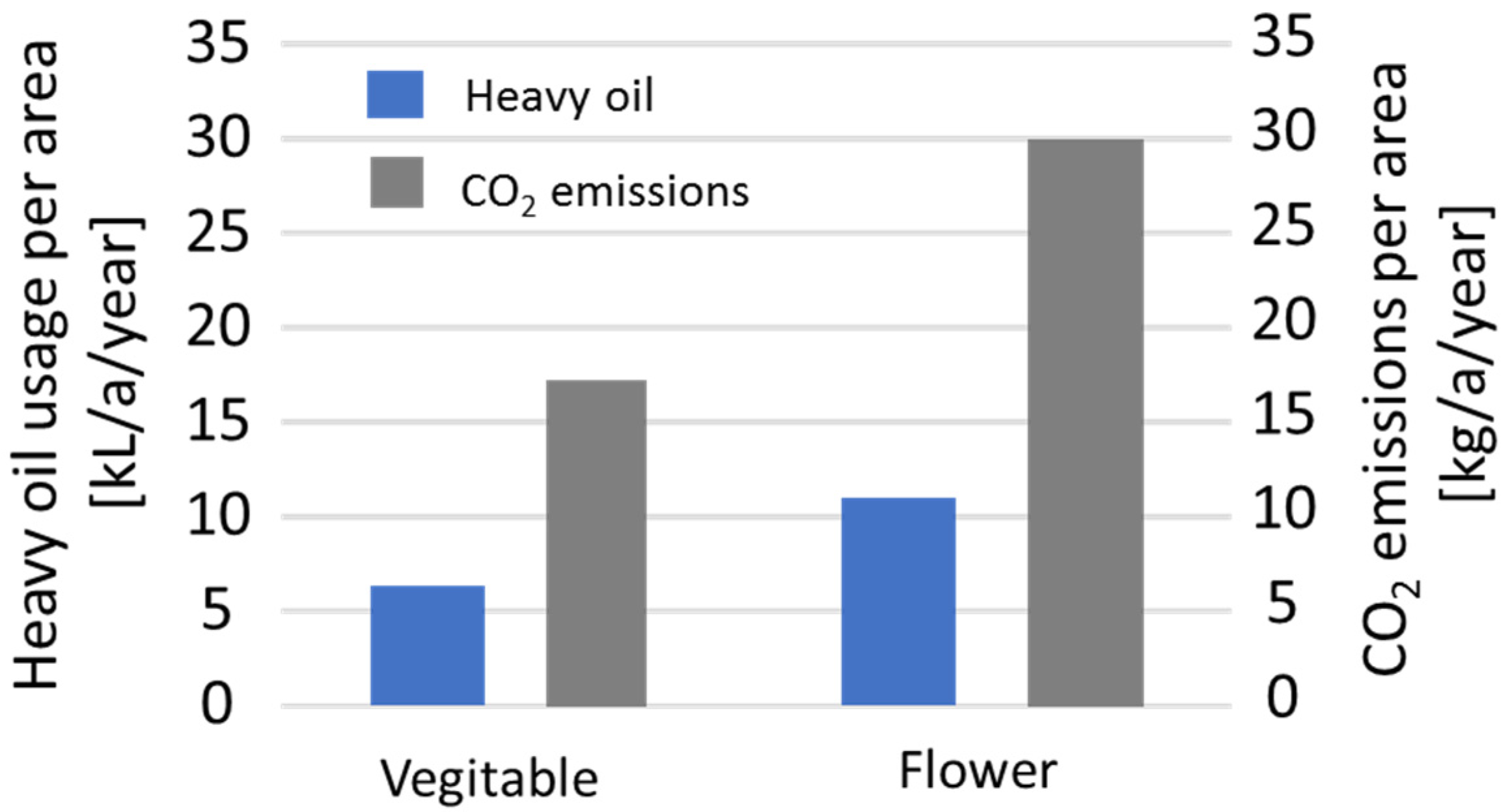

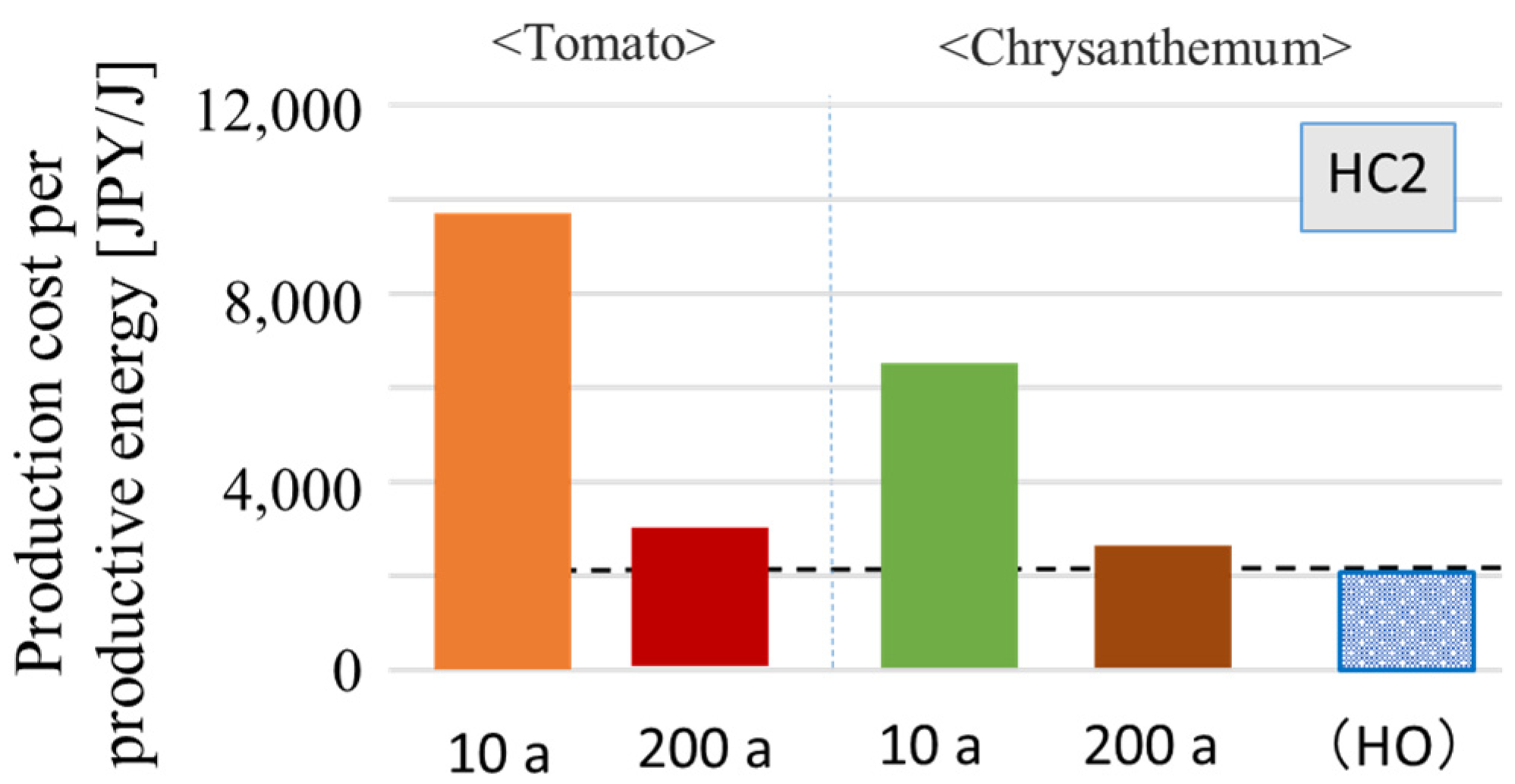
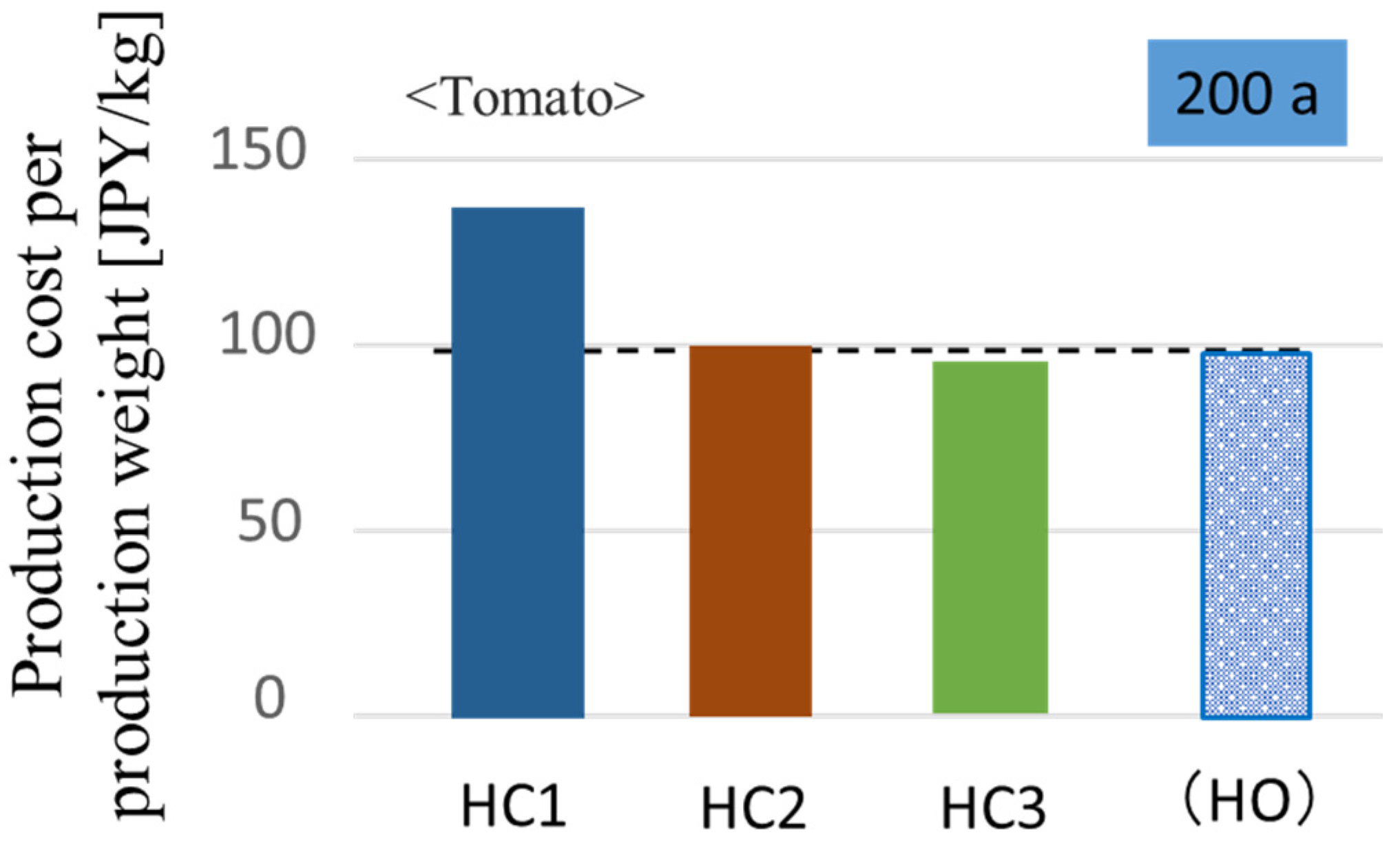



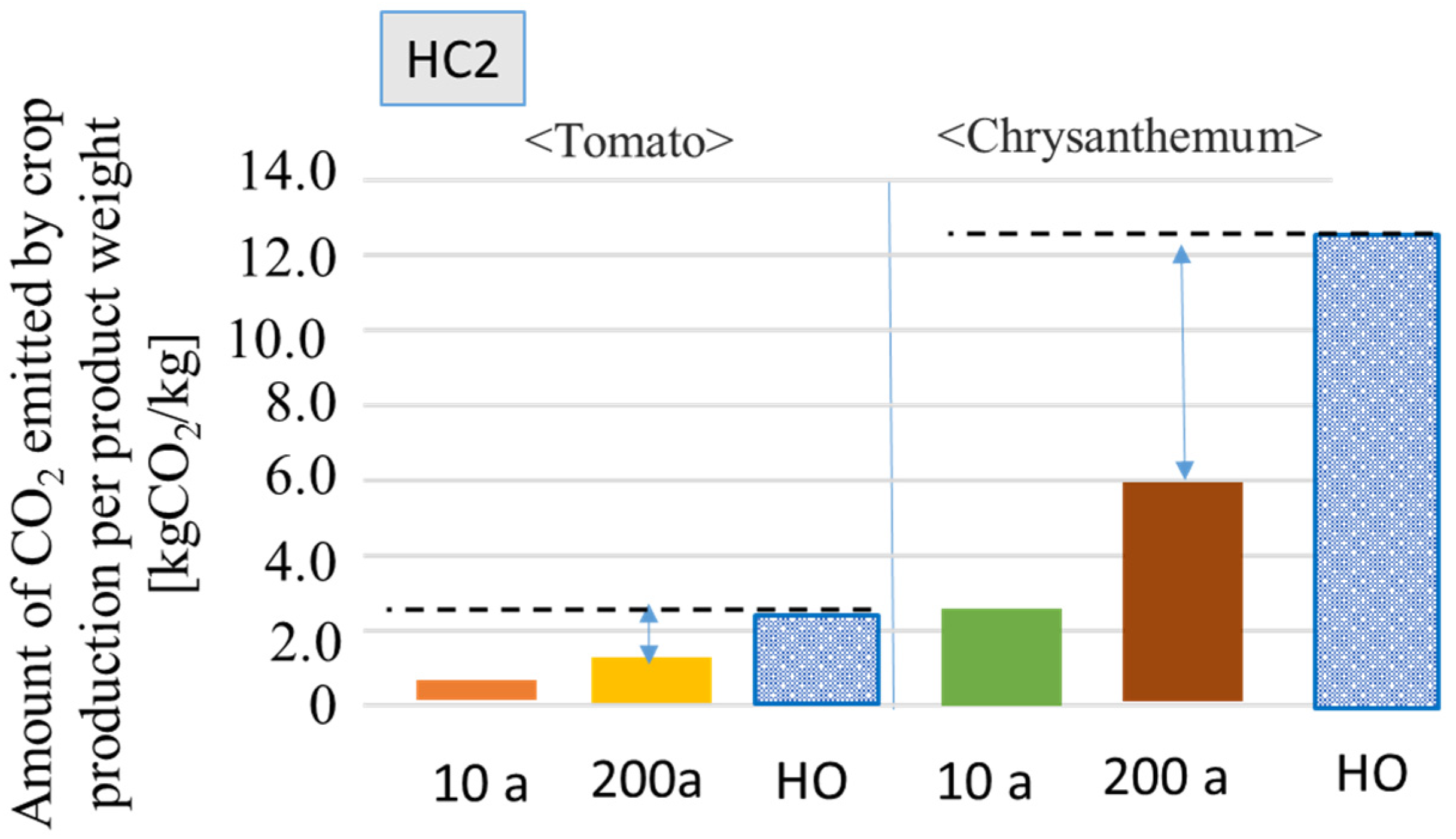
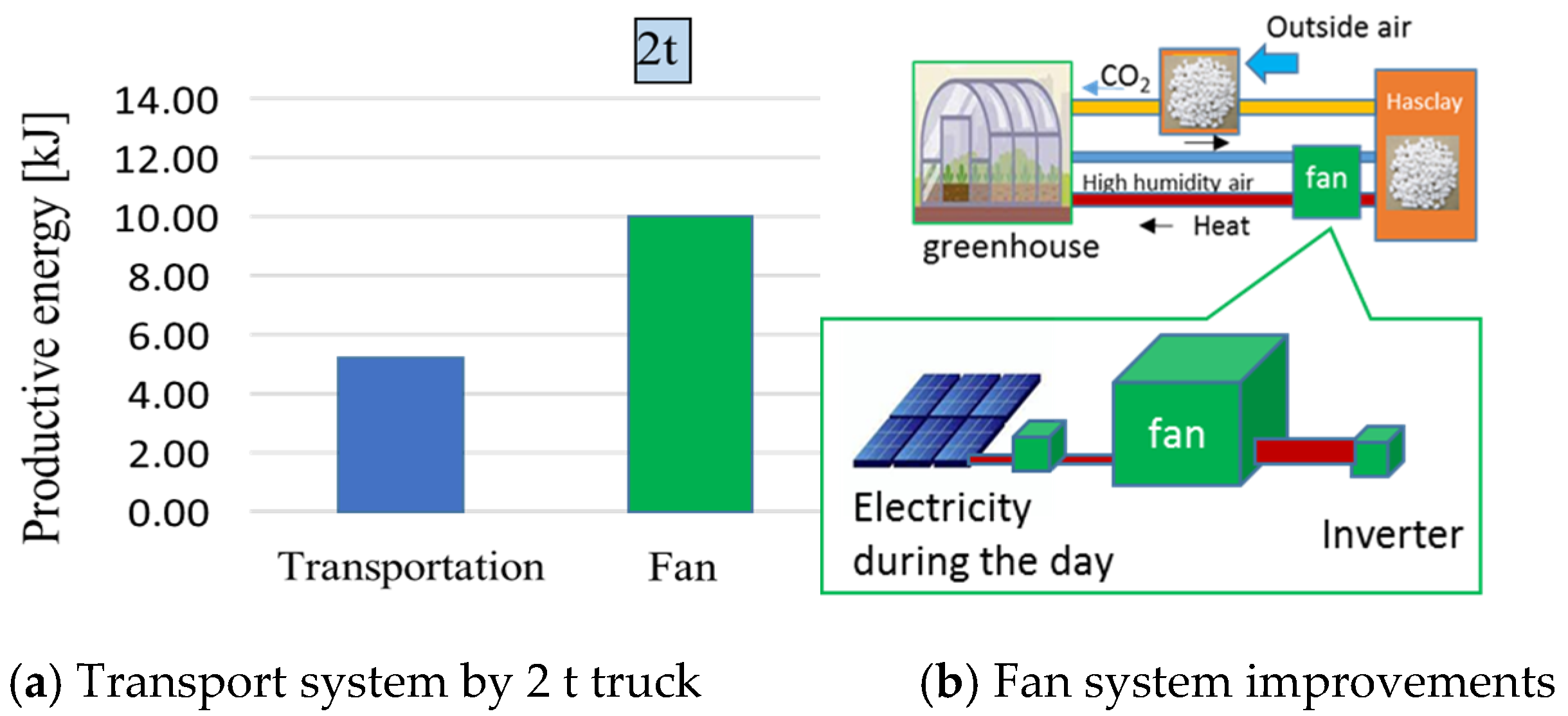
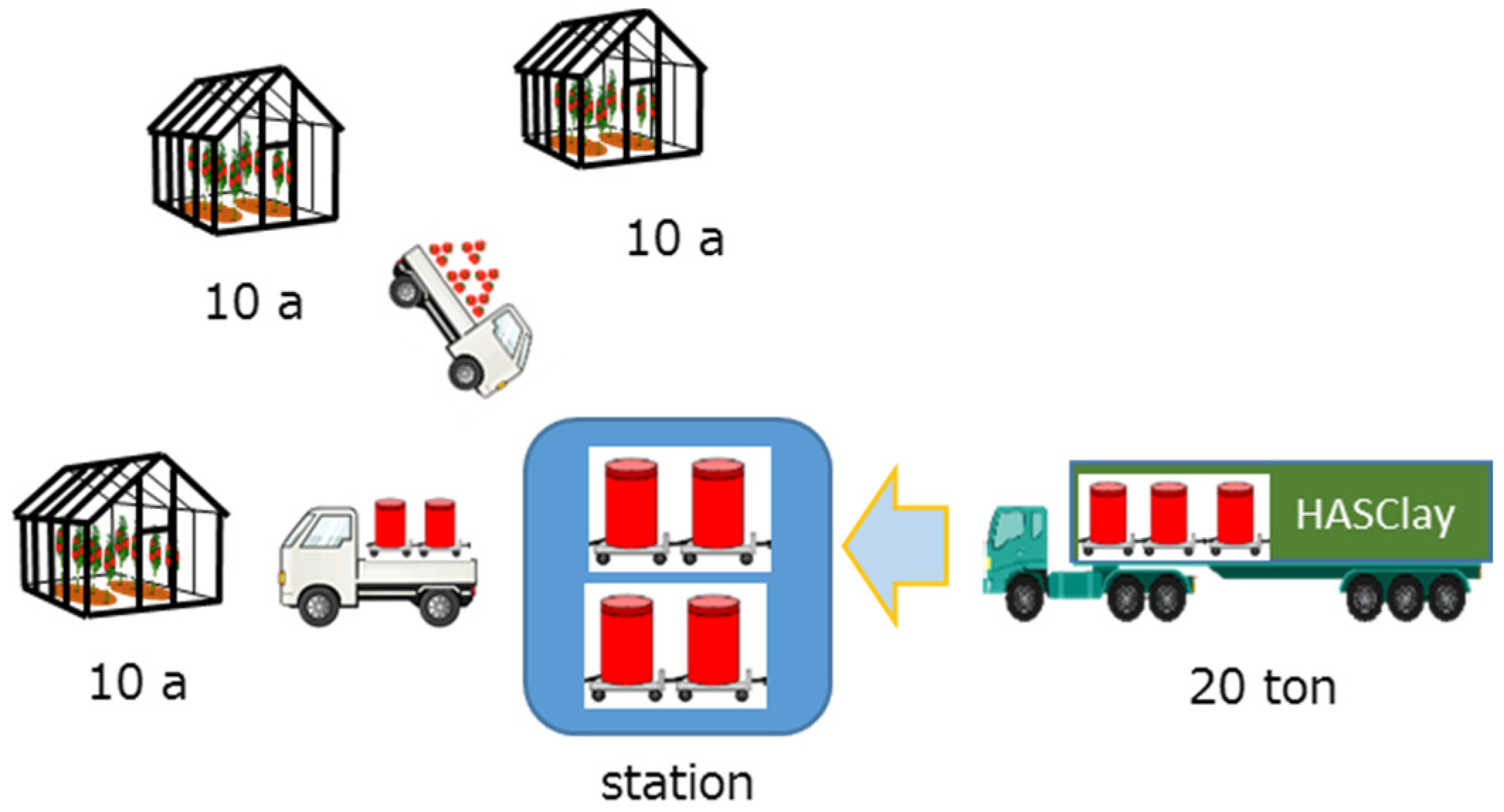
| Category | Detail Item | Value | Unit |
|---|---|---|---|
| Truck | Cargo bed volume | 61,374 | (L) |
| Maximum loading | 2000 | (kg) | |
| HASClay | Density | 1.04 | (kg/L) |
| heat transportation | Heat storage density | 588 | (kJ/L) |
| Loading capacity | 1923 | (L) | |
| Price of HASClay | 1000 | (JPY/kg) | |
| Number of times HASClay can be used | 10,000 | (times) | |
| Recovery temperature of HASClay | 100 | (°C) | |
| Amount of heat that can be transported by 2 ton truck | 0.374 | (MJ/s) | |
| Heat supply | Amount of exhaust gas | 17,000 | (Nm3/h) |
| Exhaust gas | Exhaust gas temperature | 180 | (°C) |
| Specific heat of exhaust gas | 0.25 | (kcal/Nm3·°C) | |
| Recovery temperature of heat storage material | 100 | (°C) | |
| Heat storage capacity | Recoverable heat | 0.395 | (MW) |
| Category | Detail Item | Value | Unit |
|---|---|---|---|
| Transportation cost | Container weight 1 | 2000 | (kg) |
| Truck fuel consumption | 10 | (km/L) | |
| Container weight 2 | 200,000 | (kg) | |
| Truck fuel consumption | 4 | (km/L) | |
| Number of containers | 2 | (pieces) | |
| Travel distance | 16 | (km) | |
| Diesel fuel charge | 120 | (JPY/L) | |
| Fixed cost | Labor cost | 250,000 | (JPY/month) |
| Amortization period | 10 | (year) | |
| HASClay price | 1000 | (JPY/kg) | |
| Cost of air blowing fan | 500,000 | (JPY) | |
| Electricity costs for heat dissipation | Fan power | 10.08 | (kJ/MJ) |
| Unit cost of electric power | 5.744 | (×10−3 JPY/kJ) | |
| Cost of heavy oil heating equipment | Unit calorific value | 39.1 | (GJ/kl) |
| Price of heavy oil | 81.1 | (JPY/L) | |
| Calculation of CO2 emissions factor | Diesel oil | 2.619 | (kg-CO2/L) |
| Electricity consumption | 0.143 | (×10−3 kg-CO2/kJ) | |
| Heavy oil | 2.71 | (kg-CO2/L) |
| Cultivated Varieties | Production per Area (kg/a/year) | Profit per Area (JPY/a/Year) |
|---|---|---|
| Tomato | 1019 | 31.9 |
| Strawberry | 422 | 36.8 |
| Melon | 224 | 9.20 |
| Chrysanthemum | 280 | 9.97 |
| Cabbage | 526 | 1.93 |
| Broccoli | 199 | 0.80 |
| Cabbage | 526 | 1.93 |
| Cultivated Varieties | Dry Matter Content per 1 kg (kg) | Carbon Content (kg) | CO2 Equivalent (kg) |
|---|---|---|---|
| Tomato | 0.08 | 0.03 | 0.13 |
| Melon | 0.15 | 0.08 | 0.27 |
| Strawberry | 0.12 | 0.05 | 0.18 |
| Cabbage | 0.10 | 0.04 | 0.15 |
| Broccoli | 0.10 | 0.04 | 0.15 |
| Chrysanthemum | 0.11 | 0.04 | 0.16 |
| Varieties | Season | Percentage Increase (-) |
|---|---|---|
| <CO2 application> | ||
| Tomato | Winter | 1.30 |
| Tomato | Summer | 1.10 |
| Chrysanthemum | Winter | 1.10 |
| Melon | Summer | 1.20 |
| Strawberry | Winter | 1.20 |
| <Dehumidification> | ||
| Tomato | Winter, Summer | 1.10 |
| Chrysanthemum | Winter, Summer | 1.10 |
| <Conditions 1> : | Crop type, season, transport distance, etc. | |||
| Crop type | Tomato, Chrysanthemum | |||
| Cultivation season | Winter: | 1, 2, 3, 11, 12, | (month) | |
| Summer: | 5, 6, 7, 8, 9, 10 | (month) | ||
| Transport Distance | 16 | (km) | ||
| Greenhouse size | 10, 200 | (a) | ||
| Truck size | 2000, 20,000 | (kg) | ||
| <Conditions 2> : | Heat supply method | |||
| HC1 | Heat | Winter | ||
| HC2 | Heat + CO2 | Winter | ||
| HC3 | Heat + CO2, | Winter, Summer | ||
| (HO) | Heat (from heavy oil) | Winter | ||
Publisher’s Note: MDPI stays neutral with regard to jurisdictional claims in published maps and institutional affiliations. |
© 2022 by the authors. Licensee MDPI, Basel, Switzerland. This article is an open access article distributed under the terms and conditions of the Creative Commons Attribution (CC BY) license (https://creativecommons.org/licenses/by/4.0/).
Share and Cite
Matsuo, S.; Suzuki, M.; Shimazu, T. Proposal of Agro-Industrial Integration Heat Transport System Using High-Performance Medium for the Realization of a Sustainable Society. Energies 2022, 15, 1211. https://doi.org/10.3390/en15031211
Matsuo S, Suzuki M, Shimazu T. Proposal of Agro-Industrial Integration Heat Transport System Using High-Performance Medium for the Realization of a Sustainable Society. Energies. 2022; 15(3):1211. https://doi.org/10.3390/en15031211
Chicago/Turabian StyleMatsuo, Seiji, Masaya Suzuki, and Teruaki Shimazu. 2022. "Proposal of Agro-Industrial Integration Heat Transport System Using High-Performance Medium for the Realization of a Sustainable Society" Energies 15, no. 3: 1211. https://doi.org/10.3390/en15031211






